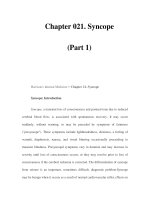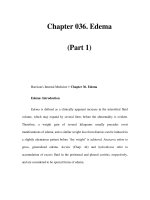day137 CHAPTER 12 pathology part 1 the sebaceous glands
Bạn đang xem bản rút gọn của tài liệu. Xem và tải ngay bản đầy đủ của tài liệu tại đây (87.73 KB, 3 trang )
CHAPTER 12: The Integumentary System
PATHOLOGY OF THE INTEGUMENTARY SYSTEM
The Sebaceous Glands [tuyến bã]
* Acne vulgaris [mụn trứng cá thông thường] (ACKnee vul-GAY-ris), commonly known as acne [mụn
trứng cá], is a chronic [mạn tính] inflammatory [viêm]
disease [bệnh] characterized by pustular [adj- mủ]
eruptions of the skin caused by an overproduction of
sebum [chất bã] around the hair shaft [thân lông].
Although often triggered by hormones in puberty [tuổi
dậy thì] and adolescence [thanh thiếu niên], it also
occurs in adults [người lớn]. Vulgaris is a Latin term
meaning common.
* A comedo [nhân trứng cá] (KOM-eh-doh) is a
noninfected lesion [thương tổn không nhiễm trùng]
formed by the buildup of sebum [chất bã] and keratin
in a hair follicle [nang lông] (plural, comedones) often
associated with acne vulgaris. A comedo with an
obstructed opening is called a whitehead (a closed
comedo). A sebum plug [nút bã] that is exposed to air
1
CHAPTER 12: The Integumentary System
often oxidizes and becomes a blackhead (an open
comedo).
* A sebaceous cyst [nang bã] (seh-BAY-shus SIST) is a
closed sac associated with a sebaceous gland [tuyến
bã] that is found just under the skin. These cysts
contain yellow, fatty material and are usually found on
the face [mặt], neck [cổ], or trunk [thân].
* Seborrhea [sự tiết bã nhờn] (seb-oh-REE-ah) is
overactivity of the sebaceous glands [tuyến bã] that
results in the production of an excessive amount of
sebum [chất bã] (seb/o means sebum, and -rrhea
means flow or discharge).
* Seborrheic dermatitis [viêm da dầu (viêm da tiết
bã)]
(seb-oh-REE-ick
der-mahTYE-tis)
is
an
inflammation sometimes resulting from seborrhea that
causes scaling [vẩy] and itching [ngứa] of the upper
layers of the skin or scalp [da đầu]. Extensive dandruff
[gàu (bám da đầu)] is a form of seborrheic dermatitis,
as is the scalp rash in infants known as cradle cap. In
2
CHAPTER 12: The Integumentary System
contrast, mild dandruff is usually caused by a yeast-like
fungus [nấm giống nấm men] on the scalp [da đầu].
* A seborrheic keratosis [dày sừng tiết bã] (seb-ohREE-ick kerr-ahTOH-sis) is a benign [lành tính] skin
growth that has a waxy or “pasted-on” loosk. These
growths, which can vary in color from light tan to
black, occur most commonly in the elderly.
3









